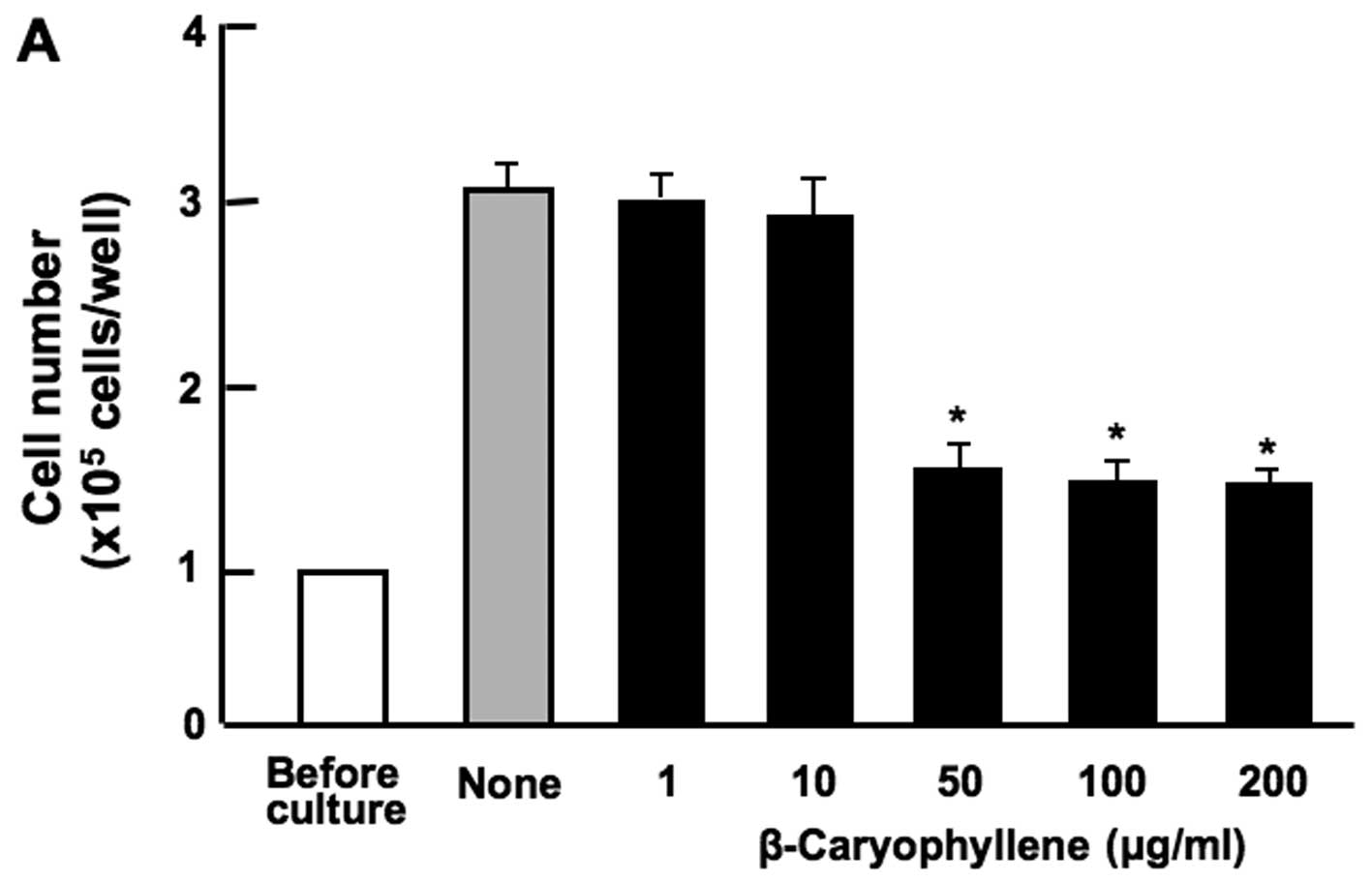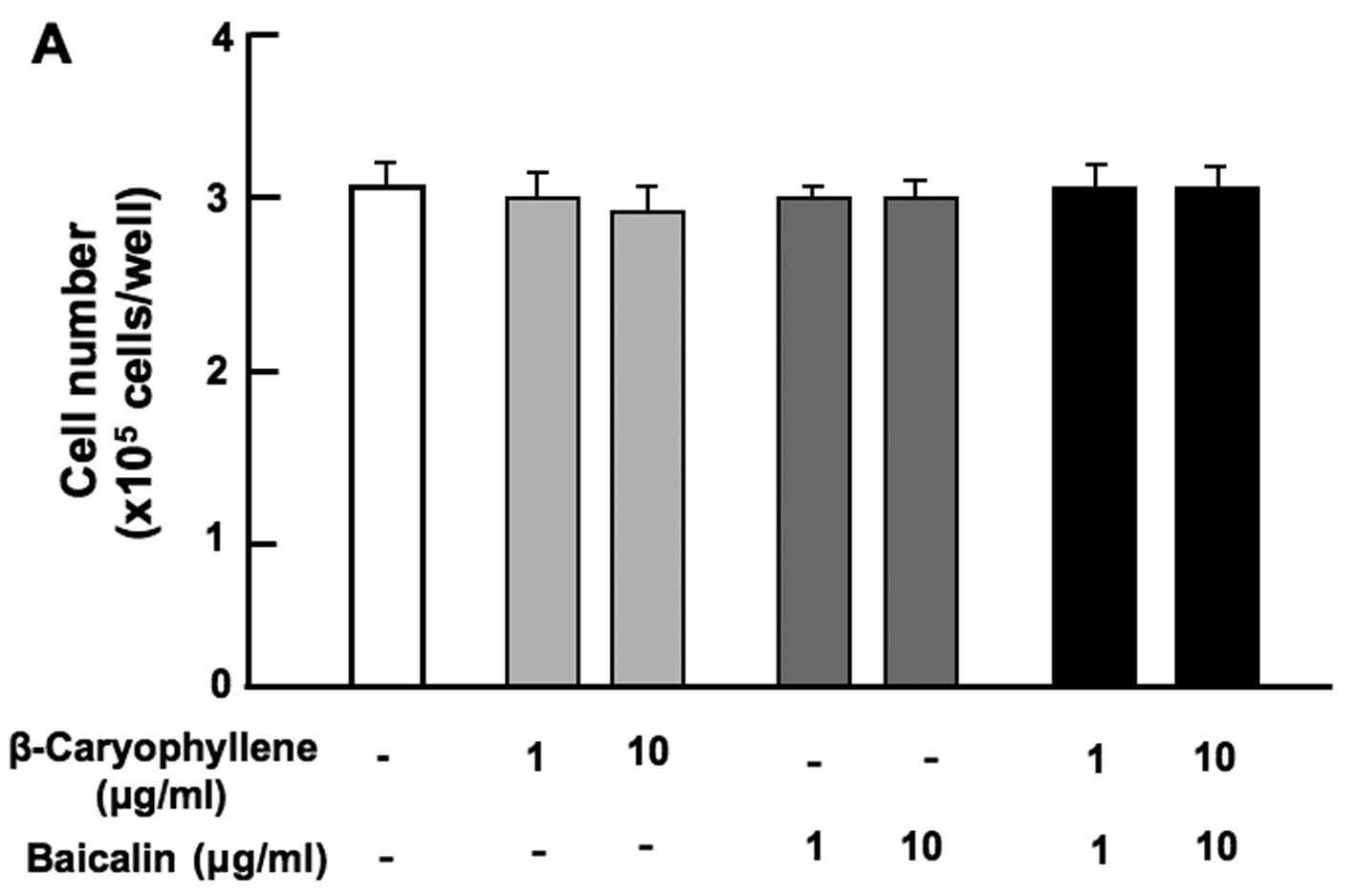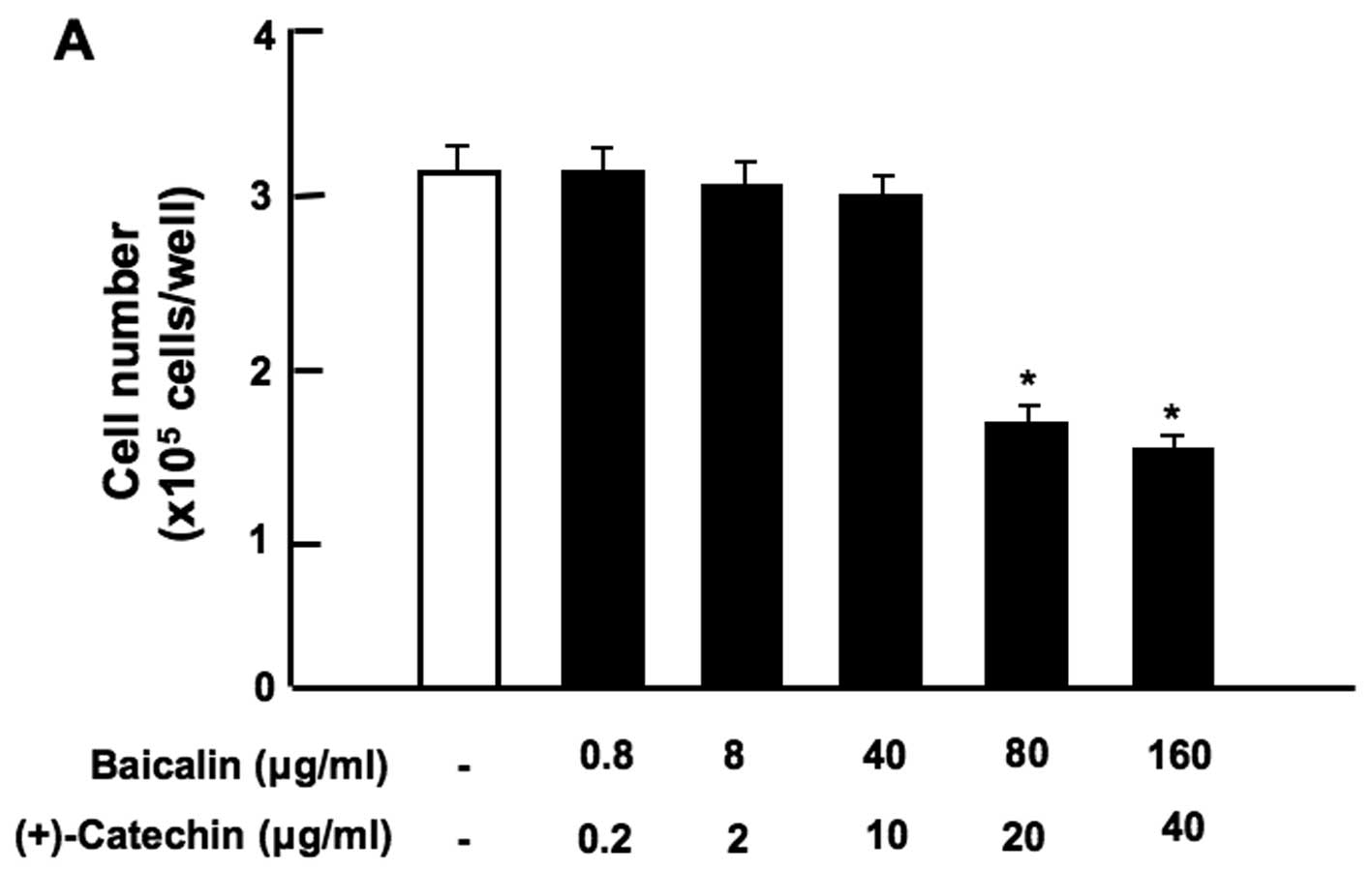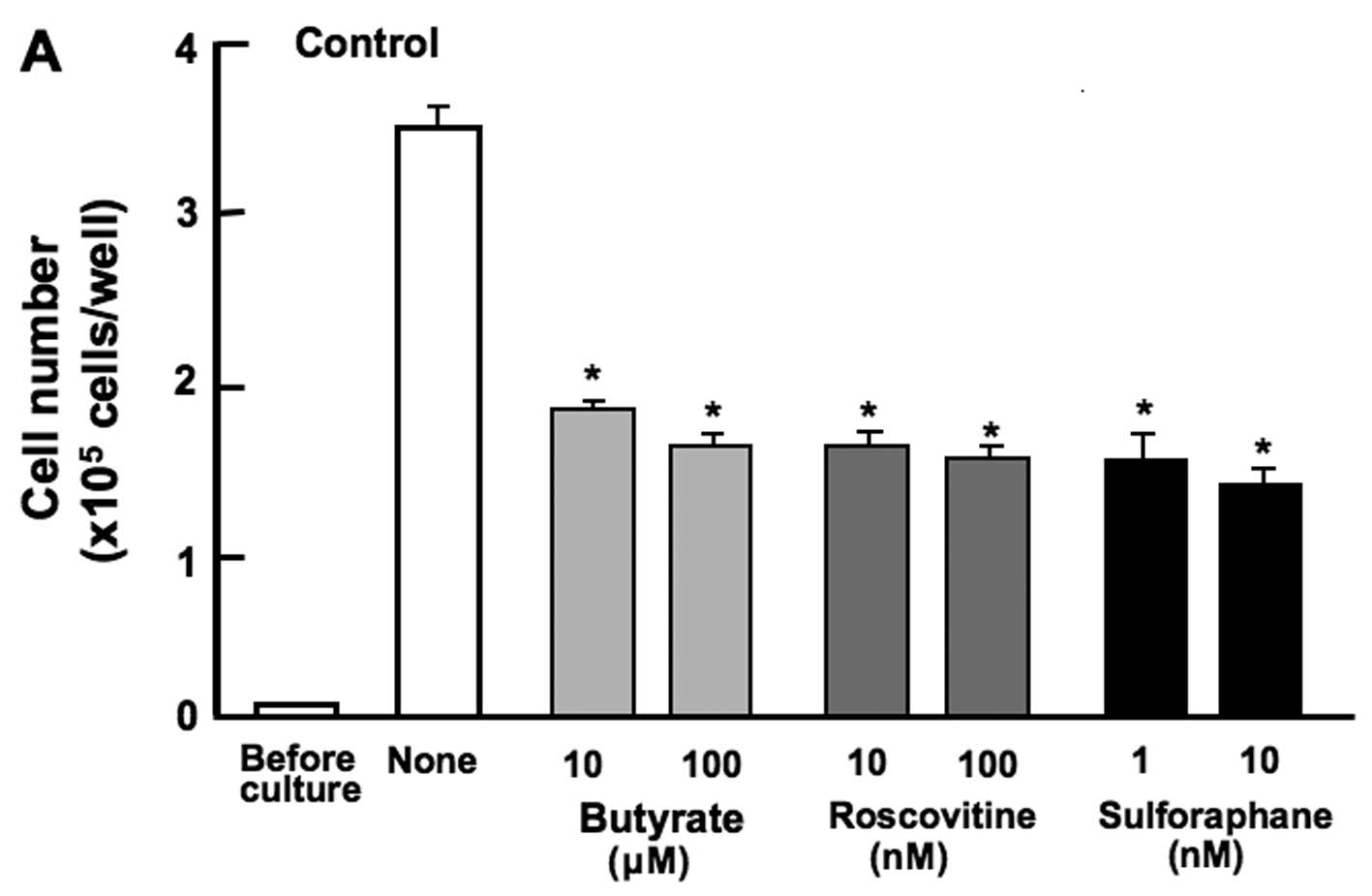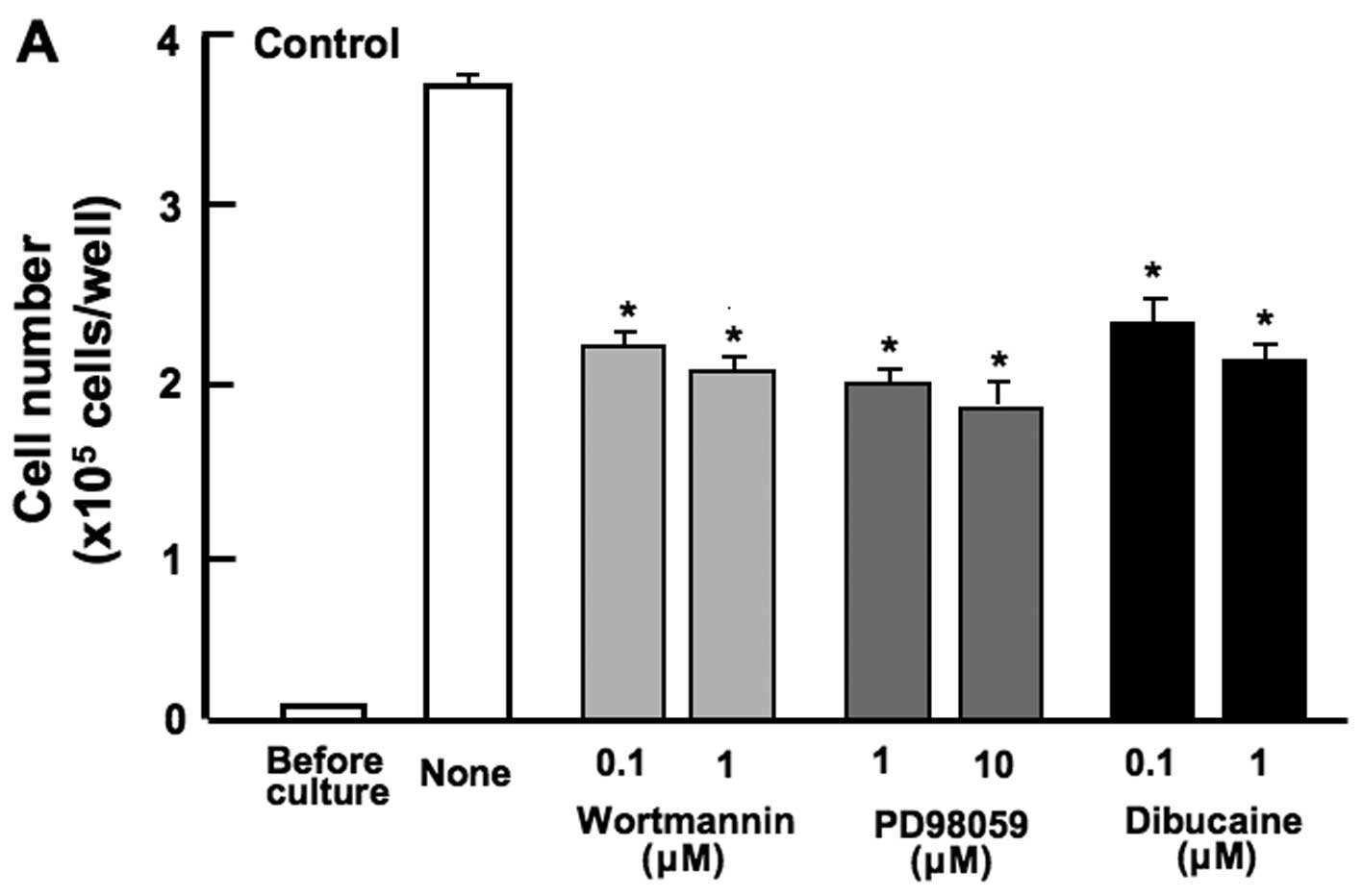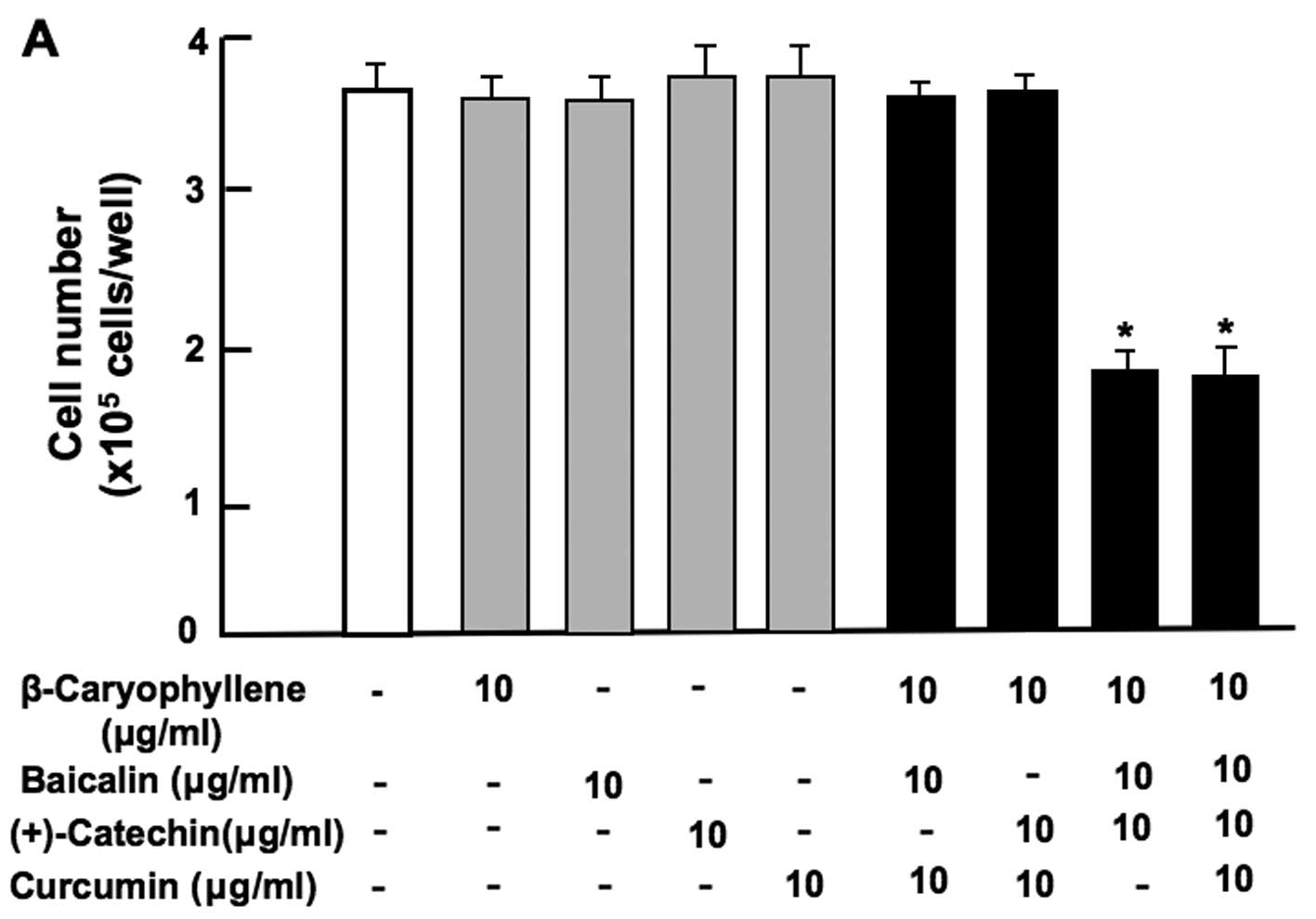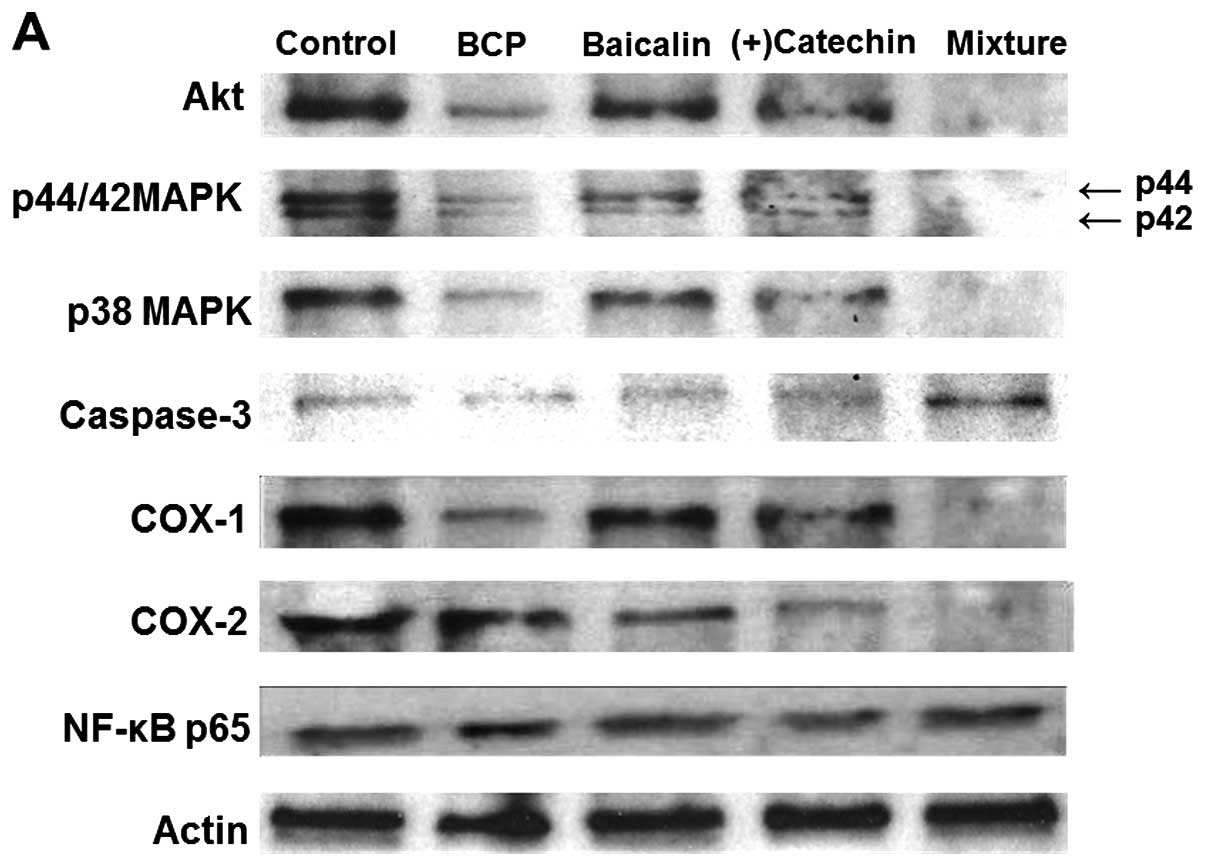The combination of β-caryophyllene, baicalin and catechin synergistically suppresses the proliferation and promotes the death of RAW267.4 macrophages in vitro
- Authors:
- Published online on: November 14, 2016 https://doi.org/10.3892/ijmm.2016.2801
- Pages: 1940-1946
Abstract
Introduction
Many botanical molecules are known to possess anti-inflammatory and analgesic effects. β-caryophyllene is a sesquiterpene, which is the essential oil of many medical plants, particularly clove (Syzygium aromaticum), hemp (Cannabis sativa), rosemary (Rosmarinus officinalis), cinnamon and hops (1–4). β-caryophyllene is natural dietary ingredient found in many edible plants ingested daily, and has been approved as a food additive by the Food and Drug Administration (FDA).
β-caryophyllene has been known to be a selective agonist of cannabinoid receptor type-2 and to exert cannabimimetic anti-inflammatory and analgesic effects in animals (2,4) for both acute and chronic pain with inflammation (4–6). The anti-inflammatory effects of β-caryophyllene are not implicated in its inhibitory effects on the production of tumor necrosis factor (TNF)-α and interleukin (IL)-1β, that are related to opioid receptors (7). RAW267.4 cells are murine macrophages that produce various inflammatory cytokines, including TNF-α and IL-1β (8). However, the effects of β-caryophyllene on RAW267.4 macrophages have not been investigated to date, at least to the best of our knowledge.
This study was undertaken to determine whether β-caryophyllene exerts suppressive effects on mouse RAW267.4 macrophages in vitro. Moreover, we compared the interactive effects of β-caryophyllene with other botanical molecules, which exert antioxidant and anti-inflammatory effects on mouse RAW267.4 macrophages in vitro. Of note, this study demonstrated that the combination of β-caryophyllene, baicalin and (+)-catechin at concentrations, which independently did not exert a significant effect on RAW267.4 cells, exerted synergistic suppressive effects on the proliferation and synergistic stimulatory effects on the death of RAW267.4 cells in vitro. To the best of our knowledge, this is the first time that such a finding has been described. This composition of agents may be a potent and useful tool as an anti-inflammatory therapeutic strategy with less toxicity.
Materials and methods
Materials
Dulbecco's modification of Eagle's medium (DMEM) with 4.5 g/l glucose, L-glutamine and sodium pyruvate and antibiotics [penicillin and streptomycin (P/S)] were purchased from Corning (Mediatech, Inc., Manassas, VA, USA). Fetal bovine serum (FBS) was from HyClone (Logan, UT, USA). β-caryophyllene, baicalin, (+)-catechin, curcumin, and (+)-aromatic turmerone were obtained from Cayman Chemical (Ann Arbor, MI, USA). TNF-α was obtained from R&D Systems (Minneapolis, MN, USA). Sodium butyrate, roscovitine, sulforaphane, PD98059, wortmannin, dibucaine, and all other reagents were purchased from Sigma-Aldrich (St. Louis, MO, USA) unless otherwise specified. The caspase-3 inhibitor (Caspase 3/CPP32 inhibitor W-1, biotin conjugate; Wako Pure Chemical Industries, Ltd., Osaka, Japan) was diluted in phosphate-buffered saline (PBS) and the other reagents were dissolved in 100% ethanol or dimethyl sulfoxide for use in the experiments.
RAW267.4 cells
Mouse RAW267.4 cells (murine macrophages) were obtained from the American Type Culture Collection (ATCC, Rockville, MD, USA) (9,10).
Cell proliferation assay
The RAW267.4 cells (1×105/ml/well) cells were cultured using a 24-well plate in DMEM containing 10% FBS and 1% P/S for 1, 2, 3 or 7 days in a water-saturated atmosphere containing 5% CO2 and 95% air at 37°C, as previously described (11). The RAW267.4 cells were cultured in DMEM containing 10% FBS and 1% P/S in the presence or absence of absence of either the vehicle (0.1% ethanol as a final concentration), β-caryophyllene [1 (5 µM), 10, 50, 100 or 200 µg/ml of medium], baicalin [1 (2.24 µM), 10, 50, 100 or 200 µg/ml], (+)-catechin [1 (3.45 µM), 10, 50, 100 or 200 µg/ml], curcumin [1 (2.72 µM), 10, 50, 100 or 200 µg/ml], or (+)-aromatic turmerone [1 (4.62 µM), 5, 10, 25 or 50 µg/ml] for 3 days. In separate experiments, the RAW267.4 cells were cultured in DMEM containing 10% FBS and 1% P/S with either the vehicle (0.1% ethanol as a final concentration) or mixture of β-caryophyllene (10 µg/ml of medium), baicalin (10 µg/ml) and (+)-catechin (10 µg/ml) in the presence or absence of either sodium butyrate (10 and 100 µM), roscovitine (10 and 100 nM), sulphoraphane (1 and 10 nM), dibucaine (0.1 or 1 µM), PD98059 (1 or 10 µM), or wortmannin (0.1 or 1 µM) for 3 days. Following culture, the cells were detached from the culture dishes and counted using the same method as described below in 'Cell counting'.
Cell death assay
The RAW267.4 cells (1×105/ml/well) were cultured using a 24-well plate in DMEM containing 10% FBS and 1% P/S for 3 days until they reached confluence, as previously described (12), and the cells were then cultured for an additional 2 days in the presence or absence of absence of either the vehicle (0.1% ethanol as a final concentration), β-caryophyllene (1 or 10 µg/ml of medium) and/or baicalin or (+)-catechin (1 or 10 µg/ml of medium) with or without caspase-3 inhibitor (10 µM). Following culture, the cells were detached from the culture dishes.
Cell counting
Following trypsinization of each culture dish using 0.2% trpysin plus 0.02% EDTA in Ca2+/Mg2+-free PBS for 2 min at 37°C, the detached cells from the dish were collected following centrifugation at 150 × g for 5 min at a room temperature, as previously described (12,13). The cells were resuspended in PBS solution and stained with eosin. Cell numbers were counted under a microscope (Olympus MTV-3; Olympus, Tokyo, Japan) using a hemocytometer plate (12,13). For each dish, we took the average of two countings. The cell number was calculated as the number of cells/well of each plate.
Western blot analysis
The RAW267.4 cells (1×105 cells/well in 2 ml of medium) were cultured in DMEM containing 10% FBS and 1% P/S in the presence or absence of either the vehicle (0.1% ethanol as a final concentration), β-caryophyllene (1 µg/ml of medium), baicalin (1 µg/ml), and/or (+)-catechin (1 µg/ml) for 3 days. In a separate experiment, the cells were cultured in the presence or absence of a combination of β-caryophyllene (1 µg/ml), baicalin (1 µg/ml) and (+)-catechin (1 µg/ml) for 3 days, and then were they cultured for an additional 24 h with or without the addition of TNF-α (10 ng/ml). Following culture, the cells were washed twice with ice-cold PBS and removed from the dish by scraping in cell lysis buffer containing protein inhibitors. The lysed cells were homogenized by sonication in 0.4 ml of ice-cold cell lyses buffer containing protein inhibitors. The homogenate was centrifuged for 5 min at 1,500 × g, and the protein concentration of the supernatant was determined for western blotting using bovine serum albumin as a standard. Samples of supernatant protein (30 µg/lane) were separated by sodium dodecyl sulfate-polyacrylamide gel electrophoresis (SDS-PAGE) and transferred to nylon membranes for western blotting using specific rabbit antibodies against Akt, mitogen-activated protein kinase (MAPK), caspase-3, cyclooxygenase (COX)-1, -2, p65, and β-actin (all form Cell Signaling Technology, Danvers, MA, USA). β-actin was used as a loading control. Donkey anti-rabbit IgG-HRP (Santa Cruz Biotechnology, Santa Cruz, CA, USA) was used as the secondary antibody for all the above antibodies. A minimum of 2 blots from independent experiments was scanned on an Epson Perfection 1660 Photo scanner, and bands quantified using ImageJ. Data from independent experiments were normalized to a percentage of control before averaging.
Statistical analysis
Statistical significance was determined using GraphPad InStat version 3 for Windows XP (GraphPad Software Inc., La Jolla, CA, USA). Multiple comparisons were performed by one-way analysis of variance (ANOVA) with Tukey-Kramer multiple comparisons post test for parametric data as indicated. A value of p<0.05 was considered to indicate a statistically significant difference.
Results
Effects of various botanical molecules on the proliferation of RAW267.4 cells
The effects of various botanical molecules [β-caryophyllene, baicalin, (+)-catechin, curcumin and (+)-aromatic turmerone], which exert anti-inflammatory effects on RAW267.4 cells in vitro have not been investigated thus far. Thus, to determine these effects, the cells were cultured for 3 days in the presence or absence of each compound. The proliferation of the RAW267.4 cells was suppressed in the presence of β-caryophyllene (50, 100 and 200 µg/ml of medium) (Fig. 1A) or curcumin (100 and 200 µg/ml) (Fig. 1B). Culture with baicalin (1, 10, 50, 100 and 200 µg/ml) (Fig. 1C) or (+)-catechin (1, 10, 50, 100 and 200 µg/ml) (Fig. 1D) did not exert a significant effect on RAW267.4 cell proliferation. Culture with (+)-aromatic turmerone (25 and 50 µg/ml) significantly increased the proliferation of RAW267.4 cells (data not shown).
The combination of β-caryophyllene, baicalin and (+)-catechin exerts a synergistic suppressive effect on the proliferation of RAW267.4 cells
Subsequently, the effects of the combination with various botanical molecules on the proliferation of RAW267.4 cells in vitro were determined. Cell proliferation was not suppressed by the combination of β-caryophyllene (1 or 10 µg/ml) with either baicalin (1 or 10 µg/ml) (Fig. 2A), (+)-catechin (1 or 10 µg/ml) (Fig. 2B), curcumin (1 or 10 µg/ml) (Fig. 2C) or (+)-aromatic turmerone (1 and 10 µg/ml) (Fig. 2D).
Notably, the combination of baicalin (80 or 160 µg/ml) and (+)-catechin (20 or 40 µg/ml) at comparatively higher concentrations exerted a significant suppressive effect on cell proliferation (Fig. 3A). Moreover, the combination of β-caryophyllene, baicalin and (+)-catechin at a lower concentration of each (1 or 10 µg/ml), which did not independently exert a significant effect on cell proliferation, was found to exert a potent synergistic suppressive effect on cell proliferation (Fig. 3B). Such an effect was also observed with a higher concentration (100 µg/ml) of β-caryophyllene, baicalin and (+)-catechin (Fig. 3B). In addition, the synergistic effects of β-caryophyllene, baicalin and (+)-catechin on cell proliferation were also observed with the combination of β-caryophyllene (1 and 10 µg/ml), baicalin (0.8 or 8 µg/ml) and (+)-catechin (0.2 or 2 µg/ml) (Fig. 3C). The synergistic effects observed with the combination of β-caryophyllene, baicalin and (+)-catechin on cell proliferation were not enhanced in the presence of curcumin (10 µg/ml) (Fig. 3D). Thus, the combination of β-caryophyllene, baicalin and (+)-catechin was shown to exert a potent synergistic suppressive effect on RAW267.4 cell proliferation in vitro.
Mechanistic characterization of the synergistic suppressive effects of β-caryophyllene, catechin and baicalin on the proliferation of RAW267.4 cells
The proliferation of the RAW267.4 cells was determined in the presence of various inhibitors that induce cell cycle arrest in vitro (Fig. 4). The cells were cultured for 3 days in the presence of butyrate (10 and 100 µM), roscovitine (10 and 100 nM), or sulforaphane (1 and 10 nM). The proliferation of RAW267.4 cells was suppressed in the presence of these inhibitors (Fig. 4A). Such effects were not altered in the cells cultured in the presence of the combination of β-caryophyllene, catechin and baicalin (Fig. 4B). Thus, the suppressive effects of the combined chemicals on the proliferation of RAW267.4 cells were not altered in the presence of butyrate, roscovitine or sulphoraphan, that induce cell cycle arrest. Roscovitine is a potent and selective inhibitor of the cyclin-dependent kinases, cdc2, cdk2m and cdk5 (13). Sulforaphane induces G2/M phase cell cycle arrest (14). Butyrate inhibits G1 progression (11). In this study, the combined use of the botanical molecules was found to induce G1 and G2/M phase cell cycle arrest in RAW267.4 cells.
Subsequently, to further determine the mechanistic characteristics responsible for the suppressive effects of the combined use of botanical molecules on cell proliferation, we examined whether the suppressive effects of the combined chemicals on the proliferation of RAW267.4 cells are modulated through various signaling factors that suppress cell proliferation. The proliferation of RAW267.4 cells was suppressed in the presence of wortmannin (0.1 or 1 µM), an inhibitor of phosphatidylinositol 3-kinase (PI3K) (15), PD98059 (1 or 10 µM), an inhibitor of extracellular signal-regulated kinase (ERK) and mitogen-activated protein kinase (MAPK) (16), or dibucaine (0.1 or 1 µM), an inhibitor of Ca2+/calmodulin-dependent protein kinase (11) (Fig. 5A). The suppressive effects of these inhibitors on cell proliferation were not observed when used in combination with β-caryophyllene, catechin and baicalin (Fig. 5B). The combined use of the botanical molecules was found to exert suppressive effects on cell proliferation by inhibiting various intracellular signaling pathways, such as the PI3K/Akt, ERK/MAPK and Ca2+ pathways in RAW267.4 cells.
Combination of β-caryophyllene, baicalin and (+)-catechin promotes the death of RAW267.4 cells in vitro
To determine whether the combination of β-caryophyllene, baicalin and (+)-catechin induces apoptotic cell death in vitro, RAW267.4 cells were cultured for 3 days until they reached confluence, and the cells were then cultured for an additional 2 days in the presence or absence of either β-caryophyllene (10 µg/ml), baicalin (10 µg/ml), or (+)-catechin (10 µg/ml) with or without caspase-3 inhibitor (10 µM) (Fig. 6). The addition of β-caryophyllene, baicalin or (+)-catechin alone did not cause a significant alteration in the number of RAW267.4 cells (Fig. 6A). However, the combination of β-caryophyllene (10 µg/ml), baicalin (10 µg/ml) and (+)-catechin (10 µg/ml) caused a significant decrease in cell number, indicating that this treatment induces cell death. Culture with curcumin (10 µg/ml) did not exert an effect on cell death (Fig. 6A). Of note, the suppressive effects of combination of the botanical molecules on cell death were completely prevented in the presence of caspase-3 inhibitor (Fig. 6B). These results suggest that the combined use of the botanical molecules induce cell death related to caspase-3, that activates nuclear DNA fragmentation, which induces apoptotic cell death (17).
Effects of β-caryophyllene, baicalin and (+)-catechin on various protein levels in RAW267.4 cells
Alterations in the expression of key proteins related to cell proliferation, apoptotic cell death and inflammation were examined by western blot analysis (Fig. 7). The combination of β-caryophyllene (1 or 10 µg/ml), baicalin (1 or 10 µg/ml) and (+)-catechin (1 or 10 µg/ml) exerted a suppressive effect on Akt, p44/42 MAPK, p38 MAPK and COX-1 and -2 expression (Fig. 7A). Culture with this combination increased caspase-3 expression, but did not alter the levels of nuclear factor-κB (NF-κB) p65 (Fig. 7A). Moreover, culture with TNF-α (10 ng/ml) caused an increase in COX-2 and NF-κB p65 expression (Fig. 7B). This effect was suppressed by the combination of β-caryophyllene, baicalin and (+)-catechin at the concentration of 1 µg/ml (Fig. 7B).
Discussion
β-caryophyllene is a cannabinoid receptor 2 agonist, which exerts anti-inflammatory effects (1–5). This study was undertaken to determine the effects of β-caryophyllene and other herbal molecules, which exert antioxidant and anti-inflammatory effects on mouse RAW267.4 macrophages in vitro. Of note, we found that the combined use of the three botanical molecules [β-caryophyllene, baicalin and (+)-catechin] at comparatively lower concentrations, which alone did not exert any effects on cell proliferation, exerted a potent synergistic-suppressive effect on the proliferation of RAW267.4 cells in vitro. These synergistic effects may provide a useful pharmacologic tool for managing inflammatory pain.
Mechanistically, the combination of β-caryophyllene, baicalin and (+)-catechin was found to induce G2/M phase cell cycle arrest in RAW267.4 cells using various inhibitors that induce cell cycle arrest in vitro. Moreover, the combined use of the botanical molecules exerted suppressive effects on cell proliferation by inhibiting various intracellular signaling pathways, such as the PI3K/Akt, ERK/MAPK and Ca2+ pathways in RAW267.4 cells, using various inhibitors (11,13–16). In addition, the combined use of the three agents was found to decrease the protein levels of Akt and MAPKs (p44/42 and p38) in RAW267.4 cells.
β-caryophyllene, baicalin and (+)-catechin did not, individually, exert a significant effect on the death of RAW267.4 cells in vitro. Importantly, the combination of β-caryophyllene, baicalin and (+)-catechin at comparatively lower concentrations of each agent was found to promote the death of RAW267.4 cells in vitro. This finding suggests that the suppressive effects on the proliferation of RAW267.4 cells exerted by the combined use of β-caryophyllene, baicalin and (+)-catechin, may be partly dependent on a promoting effect on cell death. Mechanistically, suppressive effects of the combined use of the botanical molecules on cell death were completely prevented in the presence of caspase-3 inhibitor. In addition, the combined use of the three agents increased caspase-3 expression in RAW267.4 cells. These findings suggest that the cell death induced by the combined use of the three botanical molecules is related to the activation of caspase-3, that activates nuclear DNA fragmentation, which induces apoptotic cell death (17).
Whether or not the combined effect of β-caryophyllene, baicalin and (+)-catechin on the proliferation and death of RAW267.4 cells influences inflammatory conditions, is unknown. However, we found that the combination of β-caryophyllene, baicalin and (+)-catechin decreased COX-1 and COX-2 expression in RAW267.4 cells in vitro. Inflammation-inducing factors have been reported to increase COX-2 and NF-κB p65 expression, which is related to MAPK signaling pathways (18–21). Furthermore, we found that the TNF-α-induced increased in the COX-2 and NF-κB p65 levels was suppressed by culture with the combination of the botanical molecules. These findings support the view that the combination of β-caryophyllene, baicalin and (+)-catechin exerts potent inhibitory effects on the inflammatory condition related to the function of activated macrophages.
In conclusion, this study demonstrates that a composition of botanical molecules, including β-caryophyllene, baicalin and (+)-catechin at comparatively low levels exerts potential synergistic suppressive effects on the function of macrophages related to inflammation. This composition may prove to be usefule as a novel anti-inflammatory therapy.
References
|
Ghelardini C, Galeotti N, Di Cesare Mannelli L, Mazzanti G and Bartolini A: Local anaesthetic activity of beta-caryophyllene. Farmaco. 56:387–389. 2001. View Article : Google Scholar : PubMed/NCBI | |
|
Gertsch J, Leonti M, Raduner S, Racz I, Chen JZ, Xie XQ, Altmann KH, Karsak M and Zimmer A: Beta-caryophyllene is a dietary cannabinoid. Proc Natl Acad Sci USA. 105:9099–9104. 2008. View Article : Google Scholar : PubMed/NCBI | |
|
Ormeño E, Baldy V, Ballini C and Fernandez C: Production and diversity of volatile terpenes from plants on calcareous and siliceous soils: Effect of soil nutrients. J Chem Ecol. 34:1219–1229. 2008. View Article : Google Scholar : PubMed/NCBI | |
|
Katsuyama S, Mizoguchi H, Kuwahata H, Komatsu T, Nagaoka K, Nakamura H, Bagetta G, Sakurada T and Sakurada S: Involvement of peripheral cannabinoid and opioid receptors in β-caryophyllene-induced antinociception. Eur J Pain. 17:664–675. 2013. View Article : Google Scholar | |
|
Paula-Freire LI, Andersen ML, Gama VS, Molska GR and Carlini EL: The oral administration of trans-caryophyllene attenuates acute and chronic pain in mice. Phytomedicine. 21:356–362. 2014. View Article : Google Scholar | |
|
Chavan MJ, Wakte PS and Shinde DB: Analgesic and anti-inflammatory activity of Caryophyllene oxide from Annona squamosa L. bark. Phytomedicine. 17:149–151. 2010. View Article : Google Scholar | |
|
Martinez RM, Zarpelon AC, Cardoso RD, Vicentini FT, Georgetti SR, Baracat MM, Andrei CC, Moreira IC, Verri WA Jr and Casagrande R: Tephrosia sinapou ethyl acetate extract inhibits inflammatory pain in mice: Opioid receptor dependent inhibition of TNFα and IL-1β production. Pharm Biol. 51:1262–1271. 2013. View Article : Google Scholar : PubMed/NCBI | |
|
Pomari E, Stefanon B and Colitti M: Effect of plant extracts on H2O2-induced inflammatory gene expression in macrophages. J Inflamm Res. 7:103–112. 2014.PubMed/NCBI | |
|
Yamaguchi M, Vikulina T, Arbiser JL and Weitzmann MN: Suppression of NF-κB activation by gentian violet promotes osteoblastogenesis and suppresses osteoclastogenesis. Curr Mol Med. 14:783–792. 2014. View Article : Google Scholar | |
|
Yamaguchi M and Weitzmann MN: The bone anabolic carotenoid p-hydroxycinnamic acid promotes osteoblast mineralization and suppresses osteoclast differentiation by antagonizing NF-κB activation. Int J Mol Med. 30:708–712. 2012.PubMed/NCBI | |
|
Yamaguchi M and Daimon Y: Overexpression of regucalcin suppresses cell proliferation in cloned rat hepatoma H4-II-E cells: Involvement of intracellular signaling factors and cell cycle-related genes. J Cell Biochem. 95:1169–1177. 2005. View Article : Google Scholar : PubMed/NCBI | |
|
Izumi T and Yamaguchi M: Overexpression of regucalcin suppresses cell death in cloned rat hepatoma H4-II-E cells induced by tumor necrosis factor-alpha or thapsigargin. J Cell Biochem. 92:296–306. 2004. View Article : Google Scholar : PubMed/NCBI | |
|
Meijer L, Borgne A, Mulner O, Chong JP, Blow JJ, Inagaki N, Inagaki M, Deleros JG and Moulinoux JP: Biochemical and cellular effects of roscovitine, a potent and selective inhibitor of the cyclin-dependent kinases cdc2, cdk2 and cdk5. Eur J Biochem. 243:527–536. 1997. View Article : Google Scholar : PubMed/NCBI | |
|
Singh SV, Herman-Antosiewicz A, Singh AV, Lew KL, Srivastava SK, Kamath R, Brown KD, Zhang L and Baskaran R: Sulforaphane-induced G2/M phase cell cycle arrest involves checkpoint kinase 2-mediated phosphorylation of cell division cycle 25C. J Biol Chem. 279:25813–25822. 2004. View Article : Google Scholar : PubMed/NCBI | |
|
Serrano-Nascimento C, da Silva Teixeira S, Nicola JP, Nachbar RT, Masini-Repiso AM and Nunes MT: The acute inhibitory effect of iodide excess on sodium/iodide symporter expression and activity involves the PI3K/Akt signaling pathway. Endocrinology. 155:1145–1156. 2014. View Article : Google Scholar : PubMed/NCBI | |
|
Chen S, Wang Y, Ruan W, Wang X and Pan C: Reversing multidrug resistance in hepatocellular carcinoma cells by inhibiting extracellular signal-regulated kinase/mitogen-activated protein kinase signaling pathway activity. Oncol Lett. 8:2333–2339. 2014.PubMed/NCBI | |
|
Zhao Y, Jing Z, Li Y and Mao W: Berberine in combination with cisplatin suppresses breast cancer cell growth through induction of DNA breaks and caspase-3-dependent apoptosis. Oncol Rep. 36:567–572. 2016.PubMed/NCBI | |
|
Echizen K, Hirose O, Maeda Y and Oshima M: Inflammation in gastric cancer: Interplay of the COX-2/prostaglandin E2 and Toll-like receptor/MyD88 pathways. Cancer Sci. 107:391–397. 2016. View Article : Google Scholar : PubMed/NCBI | |
|
Lin CC, Chan CM, Huang YP, Hsu SH, Huang CL and Tsai SJ: Methylglyoxal activates NF-κB nuclear translocation and induces COX-2 expression via a p38-dependent pathway in synovial cells. Life Sci. 149:25–33. 2016. View Article : Google Scholar : PubMed/NCBI | |
|
Li N, Liu BW, Ren WZ, Liu JX, Li SN, Fu SP, Zeng YL, Xu SY, Yan X, Gao YJ, Liu DF and Wang W: GLP-2 attenuates LPS-induced inflammation in BV-2 cells by inhibiting ERK1/2, JNK1/2 and NF-κB signaling pathway. Int J Mol Sci. 17:E1902016. View Article : Google Scholar | |
|
Cha SM, Cha JD, Jang EJ, Kim GU and Lee KY: Sophoraflavanone G prevents Streptococcus mutans surface antigen I/II-induced production of NO and PGE2 by inhibiting MAPK-mediated pathways in RAW 264.7 macrophages. Arch Oral Biol. 68:97–104. 2016. View Article : Google Scholar : PubMed/NCBI |



